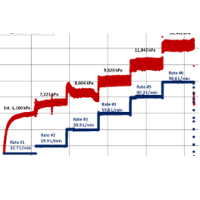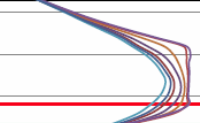Evolving maximum wellhead injection pressure process
 If you're wondering what you need to submit in support for a maximum well head injection pressure (MWHIP) increase, you'll want to look at this application. It's a great discussion on interpretation of step rate tests and maximum well head injection. We found this information using AppIntel.
If you're wondering what you need to submit in support for a maximum well head injection pressure (MWHIP) increase, you'll want to look at this application. It's a great discussion on interpretation of step rate tests and maximum well head injection. We found this information using AppIntel.
More than any other regulatory document, it traces the AER's process in determining maximum well head injection pressure from a step rate test.
?subject=Help me get an acceptable step rate test&body=Will you help me get an acceptable step rate test%0D%0A%0D%0AMy Name:__________ %0D%0AMy Phone Number:__________ %0D%0A%0D%0AUWI _____________%0D%0A%0D%0A(Or call Proven Sales at 403-803-2500.)">Contact Proven to help you make sure you get a test that will be acceptable to the regulator.
This application shows that the process is not as straight forward as it appears. In it you'll see elements of:
- supplemental information requests,
- how the regulator treats data inconsistencies,
- how they view test apparatus failures,
- how they compare data from previous applications, and
- how they negotiate final maximum well head pressure.
Recently, MWHIP has become a big issue
MWHIP became a very big issue over the last few years when oil came bubbling to the surface in the cold lake area. The regulator has since decided that the flow to surface was not the fault of high pressure injection, but rather due to subsurface salt dissolution and subsequent geologic faulting. Nevertheless, the march toward stiffer regulation of MWHIP was not deterred.
A new group was formed to evaluate MWHIP requests. Such requests were mandated to be included in a different application. Simulationists, rather than operations staff, took over this piece of regulation. Because of the changes, it became much more difficult to get the MWHIP you desire. The pendulum is still swinging on this issue so it's best to read recently approved (and refused) applications to understand the state of the MWHIP regulation.The best and fastest way to get closed applications is through AppIntel.
?subject=I want a one day trial of AppIntel&body=Sign me up fro a one day AppIntel trial so I can check out closure statistics. %0D%0A%0D%0AMy Name:___%0D%0AMy Phone Number:____%0D%0A%0D%0AType of applications:___%0D%0A%0D%0APricing: https://www1.appintel.info/short-term-search/%0D%0A%0D%0A(Or call AppIntel Sales at 403-803-2500.)">Contact us now for a one day trial.
Each AER application contains your neighbor's perspective on the exploitation of oil and gas formations. Applications contain more exploitation ideas than you can even find in SPE papers.
Would you like to see what other operators in your areas are thinking about seismic, multifractured wells, polymer schemes and recovery? AppIntel can help.
Tags: Flood, Compliance
7 Jun 2016

Steam surfactant co-injection
Want to win? What is your competitive advantage?

Surprise! Sour gas production from a sweet thermal scheme
Dealing with surprises in the oil and gas industry. What to do next.

10 ways to increase production before Christmas - Infographic
For your wall to remind you

10 ways to increase production before Christmas
Each cost less than half a million

Using AI to reduce risk of oil and gas failure
How can you assess the risk without knowing the epic fails?

Artificial intelligence using vetted oil and gas information
Using anything else is dangerous

Your AI search history is being sold to your competitors
Your use of AI is not free

Smarter acquisitions
Video demo on using the KiP box for acquisitions





 Calgary, Alberta, Canada
Calgary, Alberta, Canada
 Share
Share